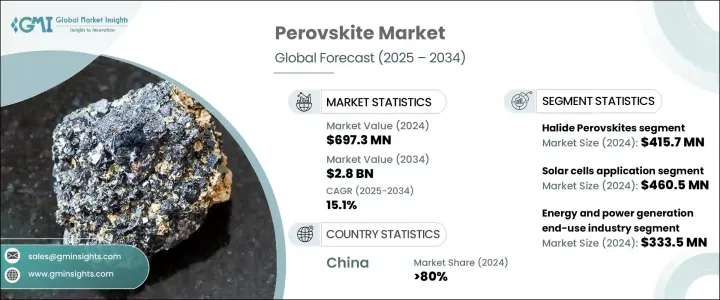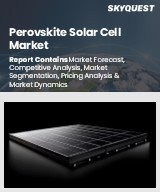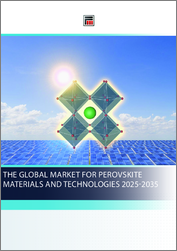
|
시장보고서
상품코드
1750311
세계의 페로브스카이트 시장 시장 기회, 성장 촉진요인, 산업 동향 분석 및 예측(2025-2034년)Perovskite Market Opportunity, Growth Drivers, Industry Trend Analysis, and Forecast 2025 - 2034 |
||||||
세계의 페로브스카이트 시장은 2024년에 6억 9,730만 달러로 평가되었고 2034년에는 CAGR 15.1%로 성장해 28억 달러에 이를 것으로 추정되고 있습니다.
에너지 인프라가 재생 가능한 통합을 지원하기 위해 적응하는 가운데, 페로브스카이트는 다용도성, 경량성, 첨단 에너지 시스템과의 호환성으로 인해 많은 사랑을 받고 있습니다. 이 소재는 부드럽고 효율적인 박막 구성의 강력한 성능으로 태양광 발전, 센서 및 소비자 전자제품의 새로운 가능성을 열어주고 있습니다.

특히 미국에서는 정부가 지지하는 지속가능성 목표가 포토닉스 및 반도체 기술 혁신에 대한 투자와 일치하고 있습니다. 실리콘과 페로브스카이트가 결합된 탠덤형 태양전지에 대한 관심이 높아지고 있으며, 이는 기존 태양광 발전의 효율을 능가할 수 있는 잠재력을 가지고 있습니다. 또한, 그 적응성은 주거용 및 상업용 시장 수요를 충족시킬 수 있는 휴대용 및 장착형 태양광 장치로의 적용을 지원합니다. 박막 전자공학의 급속한 기술 혁신은 독창적인 장치 설계를 가능하게 하고, 미래 지향적인 기술에서 페로브스카이트의 관련성을 더욱 높이고 있습니다.
| 시장 범위 | |
|---|---|
| 개시 연도 | 2024년 |
| 예측연도 | 2025-2034년 |
| 개시 금액 | 6억 9,730만 달러 |
| 예측 금액 | 28억 달러 |
| CAGR | 15.1% |
2024년 할로겐화 페로브스카이트는 4억 1,570만 달러의 매출을 기록했으며, 2034년까지 연평균 16.7%의 성장률을 보일 것으로 예측됩니다. 이들 재료는 뛰어난 광 흡수 능력으로 인해 태양전지 및 광전자 응용 분야에서 특히 효과적임이 입증되었습니다. 탠덤 태양전지 구성에서 뛰어난 성능을 발휘하는 능력은 연구자와 상업적 개발자들로부터 계속 주목받고 있습니다. 신흥 태양배터리 재료에 대한 자금이 꾸준히 증가하고 있는 것은 이러한 기술에 대한 전 세계의 신뢰가 확고하다는 것을 보여줍니다. 할로겐화 페로브스카이트와 같은 기술 혁신은 고효율 태양전지 및 포토닉스 솔루션의 발전을 가속화할 것으로 예측됩니다.
태양전지 부문은 2024년 4억 6,050만 달러 시장 규모로 66.1%의 점유율을 차지했고, 2034년까지 18%의 연평균 복합 성장률(CAGR)을 보일 것으로 예측됩니다. 페로브스카이트 태양전지의 에너지 변환 효율 향상, 특히 탠덤 구성은 전 세계 태양전지 산업에서 사용을 촉진하고 있습니다. 이 기술은 제조 비용 절감과 확장 가능한 제조 방법으로 인해 주거용 및 유틸리티 프로젝트 모두에 사용되는 태양광 패널에 점점 더 많이 통합되고 있습니다. 이러한 추세는 재생에너지로의 전환과 일치하며, 태양광이 미래의 청정 에너지 투자를 주도할 것으로 예측됩니다.
페로브스카이트 웨이퍼, 셀, 모듈과 같은 핵심 부품의 제조 역량이 전 세계적으로 집중되어 있는 중국 시장은 2024년 80%의 점유율을 차지할 것으로 예측됩니다. 이러한 광범위한 관리는 태양전지 기술의 주요 수출국으로서의 지위를 강화할 뿐만 아니라, 페로브스카이트 등 신흥 태양전지 부문의 가격 책정, 확장성 및 기술 혁신 속도에 대한 전략적 영향력을 강화하고 있습니다. 중국은 R&D에 대한 적극적인 투자, 국가 보조금, 수직적으로 통합된 제조 생태계를 통해 차세대 기술의 상용화를 가능하게 하고 있습니다.
이 시장의 주요 기업으로는 Frontier Materials, Swift Solar, Oxford PV, Saule Technologies, Microquanta Semiconductor 등이 있습니다. 주요 기업들은 생산 능력 확대, 재료 기술 혁신을 통한 효율성 향상, 에너지 공급업체 및 연구 기관과의 전략적 제휴에 주력하고 있습니다. 많은 기업들이 파일럿 생산 라인에 투자하여 대규모 배치의 실행 가능성을 테스트하는 한편, 특허를 통해 지적 재산을 보호하여 경쟁 우위를 유지하고 있습니다. 이러한 전략은 세계 수요에 대응하고 장기적으로 시장에서의 입지를 강화하기 위한 것입니다.
목차
제1장 조사 방법과 범위
제2장 주요 요약
제3장 산업 인사이트
- 생태계 분석
- 밸류체인에 영향을 미치는 요인
- 이익률 분석
- 파괴적 변화
- 전망
- 제조업체
- 유통업체
- 트럼프 정권의 관세에 대한 영향
- 무역에 대한 영향
- 무역량 혼란
- 보복 조치
- 산업에 대한 영향
- 공급측 영향(원료)
- 주요 원료 가격변동
- 공급망 재구축
- 생산비용에 대한 영향
- 수요측 영향(판매 가격)
- 최종 시장에의 가격 전달
- 시장 점유율 동향
- 소비자 반응 패턴
- 공급측 영향(원료)
- 영향을 받는 주요 기업
- 전략적인 산업 대응
- 공급망 재구성
- 가격 결정과 제품 전략
- 시책 관여
- 전망과 향후 검토사항
- 무역에 대한 영향
- 무역 통계(HS코드) 주 : 상기 무역 통계는 주요 국가에 한해 제공됩니다
- 주요 수출국
- 주요 수입국
- 이익률 분석
- 주요 뉴스와 이니셔티브
- 규제 상황
- 영향요인
- 성장 촉진요인
- 산업 잠재적 리스크와 과제
- 성장 가능성 분석
- Porter's Five Forces 분석
- PESTEL 분석
제4장 경쟁 구도
- 경쟁 구도
- 제품 포트폴리오와 사양
- SWOT 분석
- 기업의 시장 점유율 분석
- 기업의 세계 시장 점유율
- 지역 시장 점유율 분석
- 제품 포트폴리오 점유율 분석
- 전략적 이니셔티브
- 인수합병(M&A)
- 파트너십 및 협업
- 제품 발매와 혁신
- 확대 계획과 투자
- 기업 벤치마킹
- 제품 혁신 벤치마크
- 가격 전략 비교
- 배전망 비교
- 고객 서비스와 지원 비교
제5장 시장 추정·예측 : 재료별, 2021-2034년
- 주요 동향
- 할로겐 화물 페로브스카이트
- 유기 무기 하이브리드하라이드페로브스카이트
- 무기 할로겐 화물 페로브스카이트
- 납계 할로겐 화물 페로브스카이트
- 납 프리 할로겐 화물 페로브스카이트
- 산화물 페로브스카이트
- 티타늄산염계 산화물 페로브스카이트
- 강유전체 산화물 페로브스카이트
- 기타 산화물 페로브스카이트
- 기타 페로브스카이트 자료
- 이중 페로브스카이트
- 층상 페로브스카이트
- 페로브스카이트에 착상을 얻은 재료
제6장 시장 추정·예측 : 용도별, 2021-2034년
- 주요 동향
- 태양전지
- 단접합형 페로브스카이트 태양전지
- 텐덤 페로브스카이트 실리콘 태양전지
- 연질 페로브스카이트 태양전지
- 건물 일체형 태양광발전(BIPV)
- 우주 용도
- LED
- 디스플레이 기술
- 조명 용도
- 광검출기와 센서
- X선 검출기
- 광검출기
- 가스 센서
- 압력 센서
- 레이저 및 광학 용도
- 에너지 저장 장비
- 양자 컴퓨팅 용도
- 기타
- 촉매
- 열전 디바이스
- 뉴로모픽 컴퓨팅
제7장 시장 추정·예측 : 최종 이용 산업별, 2021-2034년
- 주요 동향
- 에너지 및 발전
- 일렉트로닉스 및 옵토일렉트로닉스
- 건축자재
- 자동차 및 운송
- 항공우주 및 방위
- 헬스케어 및 의료기기
- 통신
- 기타
제8장 시장 추정·예측 : 지역별, 2021-2034년
- 주요 동향
- 북미
- 미국
- 캐나다
- 유럽
- 독일
- 영국
- 프랑스
- 스페인
- 이탈리아
- 기타 유럽
- 아시아태평양
- 중국
- 인도
- 일본
- 호주
- 한국
- 기타 아시아태평양
- 라틴아메리카
- 브라질
- 멕시코
- 아르헨티나
- 기타 라틴아메리카
- 중동 및 아프리카
- 사우디아라비아
- 남아프리카공화국
- 아랍에미리트(UAE)
- 기타 중동 및 아프리카
제9장 기업 개요
- Oxford PV
- Saule Technologies
- Microquanta Semiconductor
- Swift Solar
- Frontier Materials
- Toshiba
- Panasonic
- Sekisui Chemical
- Hanwha Vision
- GCL Suzhou Nanotechnology
- EneCoat Technologies
- Kaneka Corporation
- Aisin Corporation
- UtmoLight
- Wonder Solar
- Other Notable Players
The Global Perovskite Market was valued at USD 697.3 million in 2024 and is estimated to grow at a CAGR of 15.1% to reach USD 2.8 billion by 2034, driven by the rising global attention toward sustainable energy and material innovation in the spotlight, especially in clean energy applications. As energy infrastructures adapt to support renewable integration, perovskites are gaining traction due to their versatility, lightweight properties, and compatibility with advanced energy systems. These materials are unlocking new possibilities in solar power, sensors, and consumer electronics thanks to their strong performance in flexible and efficient thin-film configurations.

Ongoing R&D is driven by public and private initiatives focused on accelerating energy transformation, particularly in the United States, where government-backed sustainability targets align with investments in photonics and semiconductor innovation. Interest is growing in combining silicon with perovskite for tandem solar cell use, offering potential to exceed the efficiency levels of traditional photovoltaics. Their adaptability also supports applications in portable and wearable solar devices, addressing demand from residential and commercial markets. Rapid innovation in thin-film electronics enables creative device designs, further increasing the relevance of perovskites in future-facing technologies.
| Market Scope | |
|---|---|
| Start Year | 2024 |
| Forecast Year | 2025-2034 |
| Start Value | $697.3 Million |
| Forecast Value | $2.8 Billion |
| CAGR | 15.1% |
In 2024, halide perovskites generated USD 415.7 million and are expected to grow at a CAGR of 16.7% through 2034. These materials are proving especially effective in solar and optoelectronic applications because of their exceptional light absorption capabilities. Their ability to perform well in tandem solar configurations continues to draw attention from researchers and commercial developers. A steady increase in funding for emerging solar materials indicates robust global confidence in these technologies. Innovations involving halide perovskites are expected to accelerate progress in high-efficiency solar and photonics solutions.
The solar cell segment dominated the market with USD 460.5 million in 2024, holding a 66.1% share and anticipated to grow at 18% CAGR through 2034. The improved energy conversion efficiency of perovskite solar cells, especially in tandem configurations, propels their use in the global solar industry. Technology is increasingly being integrated into solar panels used in both residential and utility-scale projects due to reduced manufacturing costs and scalable fabrication methods. This trend aligns with the global transition toward renewable energy, with solar projected to lead future clean energy investments.
China Perovskite Market held 80% share in 2024, driven by the world's manufacturing capacity for critical components, such as wafers, cells, and modules, concentrated within its borders. This extensive control not only strengthens its position as the primary exporter of solar technologies but also reinforces its strategic influence over the pricing, scalability, and innovation pace across emerging solar segments, including perovskites. China's aggressive investments in R&D, state-backed subsidies, and vertically integrated manufacturing ecosystems enable it to commercialize next-generation technologies.
Top companies in this market include Frontier Materials, Swift Solar, Oxford PV, Saule Technologies, and Microquanta Semiconductor. To secure their positions, leading companies focus on scaling production capabilities, enhancing efficiency through material innovation, and forming strategic partnerships with energy providers and research institutions. Many invest in pilot production lines to test large-scale deployment viability while protecting their IP through patents to maintain a competitive advantage. These strategies are designed to meet global demand and reinforce long-term market presence.
Table of Contents
Chapter 1 Methodology & Scope
- 1.1 Market scope & definitions
- 1.2 Base estimates & calculations
- 1.3 Forecast calculations
- 1.4 Data sources
- 1.4.1 Primary
- 1.4.2 Secondary
- 1.4.2.1 Paid sources
- 1.4.2.2 Public sources
Chapter 2 Executive Summary
- 2.1 Industry synopsis, 2021-2034
Chapter 3 Industry Insights
- 3.1 Industry ecosystem analysis
- 3.1.1 Factor affecting the value chain
- 3.1.2 Profit margin analysis
- 3.1.3 Disruptions
- 3.1.4 Outlook
- 3.1.5 Manufacturers
- 3.1.6 Distributors
- 3.2 Trump administration tariffs
- 3.2.1 Impact on trade
- 3.2.1.1 Trade volume disruptions
- 3.2.1.2 Retaliatory measures
- 3.2.2 Impact on the industry
- 3.2.2.1 Supply-side impact (raw materials)
- 3.2.2.1.1 Price volatility in key materials
- 3.2.2.1.2 Supply chain restructuring
- 3.2.2.1.3 Production cost implications
- 3.2.2.2 Demand-side impact (selling price)
- 3.2.2.2.1 Price transmission to end markets
- 3.2.2.2.2 Market share dynamics
- 3.2.2.2.3 Consumer response patterns
- 3.2.2.1 Supply-side impact (raw materials)
- 3.2.3 Key companies impacted
- 3.2.4 Strategic industry responses
- 3.2.4.1 Supply chain reconfiguration
- 3.2.4.2 Pricing and product strategies
- 3.2.4.3 Policy engagement
- 3.2.5 Outlook and Future Considerations
- 3.2.1 Impact on trade
- 3.3 Trade statistics (HS Code) Note: the above trade statistics will be provided for key countries only.
- 3.3.1 Major exporting countries
- 3.3.2 Major importing countries
- 3.4 Profit margin analysis
- 3.5 Key news & initiatives
- 3.6 Regulatory landscape
- 3.7 Impact forces
- 3.7.1 Growth drivers
- 3.7.1.1 Rising global energy demand driving next-generation photovoltaic adoption
- 3.7.1.2 Favorable government incentives for clean and decentralized energy systems
- 3.7.1.3 Superior efficiency and cost advantages of perovskite-based solar technologies
- 3.7.1.4 Increasing off-grid electrification projects in developing and remote regions
- 3.7.2 Industry pitfalls & challenges
- 3.7.2.1 Stability and durability concerns of perovskite materials in harsh environments
- 3.7.2.2 Lack of established large-scale manufacturing and commercialization infrastructure
- 3.7.1 Growth drivers
- 3.8 Growth potential analysis
- 3.9 Porter's analysis
- 3.10 PESTEL analysis
Chapter 4 Competitive Landscape, 2024
- 4.1 Competitive landscape
- 4.1.1 Company overview
- 4.1.2 Product portfolio and specifications
- 4.1.3 Swot analysis
- 4.2 Company market share analysis, 2024
- 4.2.1 Global market share by company
- 4.2.2 Regional market share analysis
- 4.2.3 Product portfolio share analysis
- 4.3 Strategic initiative
- 4.3.1 Mergers and acquisitions
- 4.3.2 Partnerships and collaborations
- 4.3.3 Product launches and innovations
- 4.3.4 Expansion plans and investments
- 4.4 Company benchmarking
- 4.4.1 Product innovation benchmarking
- 4.4.2 Pricing strategy comparison
- 4.4.3 Distribution network comparison
- 4.4.4 Customer service and support comparison
Chapter 5 Market Estimates & Forecast, By Material Type, 2021-2034 (USD Million) (Kilo Tons)
- 5.1 Key trends
- 5.2 Halide perovskites
- 5.2.1 Organic-inorganic hybrid halide perovskites
- 5.2.2 All-inorganic halide perovskites
- 5.2.3 Lead-based halide perovskites
- 5.2.4 Lead-free halide perovskites
- 5.3 Oxide perovskites
- 5.3.1 Titanate-based oxide perovskites
- 5.3.2 Ferroelectric oxide perovskites
- 5.3.3 Other oxide perovskites
- 5.4 Other perovskite materials
- 5.4.1 Double perovskites
- 5.4.2 Layered perovskites
- 5.4.3 Perovskite-inspired materials
Chapter 6 Market Estimates & Forecast, By Application, 2021-2034 (USD Million) (Kilo Tons)
- 6.1 Key trends
- 6.2 Solar cells
- 6.2.1 Single-junction perovskite solar cells
- 6.2.2 Tandem perovskite-silicon solar cells
- 6.2.3 Flexible perovskite solar cells
- 6.2.4 Building-integrated photovoltaics (bipv)
- 6.2.5 Space applications
- 6.3 Light-emitting diodes (leds)
- 6.3.1 Display technologies
- 6.3.2 Lighting applications
- 6.4 Photodetectors and sensors
- 6.4.1 X-ray detectors
- 6.4.2 Photodetectors
- 6.4.3 Gas sensors
- 6.4.4 Pressure sensors
- 6.5 Lasers and optical applications
- 6.6 Energy storage devices
- 6.7 Quantum computing applications
- 6.8 Other applications
- 6.8.1 Catalysis
- 6.8.2 Thermoelectric devices
- 6.8.3 Neuromorphic computing
Chapter 7 Market Estimates & Forecast, By End Use Industry, 2021-2034 (USD Million) (Kilo Tons)
- 7.1 Key trends
- 7.2 Energy and power generation
- 7.3 Electronics and optoelectronics
- 7.4 Construction and building materials
- 7.5 Automotive and transportation
- 7.6 Aerospace and defense
- 7.7 Healthcare and medical devices
- 7.8 Telecommunications
- 7.9 Others
Chapter 8 Market Estimates & Forecast, By Region, 2021-2034 (USD Million) (Kilo Tons)
- 8.1 Key trends
- 8.2 North America
- 8.2.1 U.S.
- 8.2.2 Canada
- 8.3 Europe
- 8.3.1 Germany
- 8.3.2 UK
- 8.3.3 France
- 8.3.4 Spain
- 8.3.5 Italy
- 8.3.6 Rest of Europe
- 8.4 Asia Pacific
- 8.4.1 China
- 8.4.2 India
- 8.4.3 Japan
- 8.4.4 Australia
- 8.4.5 South Korea
- 8.4.6 Rest of Asia Pacific
- 8.5 Latin America
- 8.5.1 Brazil
- 8.5.2 Mexico
- 8.5.3 Argentina
- 8.5.4 Rest of Latin America
- 8.6 Middle East and Africa
- 8.6.1 Saudi Arabia
- 8.6.2 South Africa
- 8.6.3 UAE
- 8.6.4 Rest of Middle East and Africa
Chapter 9 Company Profiles
- 9.1 Oxford PV
- 9.2 Saule Technologies
- 9.3 Microquanta Semiconductor
- 9.4 Swift Solar
- 9.5 Frontier Materials
- 9.6 Toshiba
- 9.7 Panasonic
- 9.8 Sekisui Chemical
- 9.9 Hanwha Vision
- 9.10 GCL Suzhou Nanotechnology
- 9.11 EneCoat Technologies
- 9.12 Kaneka Corporation
- 9.13 Aisin Corporation
- 9.14 UtmoLight
- 9.15 Wonder Solar
- 9.16 Other Notable Players



















